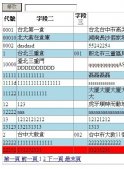核心代码:
复制代码代码如下:
public class Mail
{
#region 邮件参数
static public string accountName = System.Configuration.ConfigurationManager.AppSettings["SmtpAccountName"];
static public string password = System.Configuration.ConfigurationManager.AppSettings["SmtpAccountPW"];
static public string smtpServer = System.Configuration.ConfigurationManager.AppSettings["SmtpServer"];
static public int smtpPort = int.Parse(System.Configuration.ConfigurationManager.AppSettings["SmtpPort"]);
#endregion
/// <summary>
/// 邮件发送方法一
/// </summary>
/// <param name="sendTo"></param>
/// <param name="subject"></param>
/// <param name="body"></param>
static public void SendMail(string sendTo, string subject, string body)
{
//.net smtp
System.Web.Mail.MailMessage mailmsg = new System.Web.Mail.MailMessage();
mailmsg.To = sendTo;
//mailmsg.Cc = cc;
mailmsg.Subject = subject;
mailmsg.Body = body;
mailmsg.BodyFormat = MailFormat.Html;
//sender here
mailmsg.From = Mail.accountName;
// certify needed
mailmsg.Fields.Add("http://schemas.microsoft.com/cdo/configuration/smtpauthenticate", "1");//1 is to certify
//the user id
mailmsg.Fields.Add(
"http://schemas.microsoft.com/cdo/configuration/sendusername",
Mail.accountName);
//the password
mailmsg.Fields.Add(
"http://schemas.microsoft.com/cdo/configuration/sendpassword",
Mail.password);
System.Web.Mail.SmtpMail.SmtpServer = Mail.smtpServer;
System.Web.Mail.SmtpMail.Send(mailmsg);
}
/// <summary>
/// 邮件发送方法二
/// </summary>
/// <param name="sendTo"></param>
/// <param name="subject"></param>
/// <param name="body"></param>
static public void SendMail2(string sendTo, string subject, string body)
{
System.Net.Mail.MailMessage msg = new System.Net.Mail.MailMessage(accountName, sendTo, subject, body);
msg.From = new System.Net.Mail.MailAddress(accountName, "Mail");
System.Net.Mail.SmtpClient client = new System.Net.Mail.SmtpClient(smtpServer);
msg.IsBodyHtml = true;
client.Credentials = new System.Net.NetworkCredential(accountName, password);
client.DeliveryMethod = System.Net.Mail.SmtpDeliveryMethod.Network;
client.Send(msg);
}
}
摘要
本文简单介绍了SMTP协议(RFC2554)发送邮件的过程,并讨论了在 .NET 中使用SMTP发送邮件由简到繁的三种不同方案、各自可能遇到的问题及其解决办法。
目录
? .NET的SMTP类
? 使用CDO组件发送邮件
? 使用Socket撰写邮件发送程序
总结
简介
邮件发送功能常常是许多.NET应用,尤其是带网络功能的应用中不可缺少的模块之一,本文就此介绍了使用.NET的SMTP类库和另两种分别通过CDO(Collaboration Data Objects)及Socket来实现发送邮件功能的方法。
.NET的SMTP类
首先,我们来介绍一下.NET类库种自带的SMTP类。在.NET中的System.Web.Mail名字空间下,有一个专门使用SMTP协议来发送邮件的类:SmtpMail,它已能满足最普通的发送邮件的需求。这个类只有一个自己的公共函数--Send()和一个公共属性—SmtpServer,如下图:
您必须通过SmtpServer属性来指定发送邮件的服务器的名称(或IP地址),然后再调用
Send()函数来发送邮件。
代码示例如下:
(in C#)
复制代码代码如下:
using System.Web.Mail;
public void sendMail()
{
try
{
System.Web.Mail.MailMessage myMail=new MailMessage();
myMail.From = "myaccount@test.com";
myMail.To = "myaccount@test.com";
myMail.Subject = "MailTest";
myMail.Priority = MailPriority.Low;
myMail.BodyFormat = MailFormat.Text;
myMail.Body = "Test";
SmtpMail.SmtpServer="smarthost"; //your smtp server here
SmtpMail.Send(myMail);
}
catch(Exception e)
{
throw e;
}
}
您可以在Send函数的参数MailMessage对象中设置邮件的相关属性,如优先级、附件等等。除了以MailMessage对象为参数(如上述代码),Send函数还可以简单的直接以邮件的4个主要信息(from,to,subject,messageText)作为字符串参数来调用。
使用CDO组件发送邮件
CDO是Collaboration Data Objects的简称,它是一组高层的COM对象集合,并经历了好几个版本的演化,现在在Windows2000和Exchange2000中使用的都是CDO2.0的版本(分别为cdosys.dll和cdoex.dll)。CDOSYS构建在SMTP协议和NNTP协议之上,并且作为Windows2000 Server的组件被安装,您可以在系统目录(如c:\winnt或c:\windows)的system32子目录中找到它(cdosys.dll)。
CDO组件相对于先前介绍的SmtpMail对象功能更为丰富,并提供了一些SmtpMail类所没有提供的功能,如通过需要认证的SMTP服务器发送邮件等。
下面一段代码就展示了如何使用CDO组件通过需要认证的SMTP服务器发送邮件的过程:
(in C#)
复制代码代码如下:
public void CDOsendMail()
{
try
{
CDO.Message oMsg = new CDO.Message();
oMsg.From = "myaccount@test.com";
oMsg.To = "myaccount@test.com";
oMsg.Subject = "MailTest";
oMsg.HTMLBody = "<html><body>Test</body></html>";
CDO.IConfiguration iConfg = oMsg.Configuration;
ADODB.Fields oFields = iConfg.Fields;
oFields["http://schemas.microsoft.com/cdo/configuration/sendusing"].Value=2;
oFields["http://schemas.microsoft.com/cdo/configuration/sendemailaddress"].Value="myaccount@test.com"; //sender mail oFields["http://schemas.microsoft.com/cdo/configuration/smtpaccountname"].Value="myaccount@test.com"; //email account oFields["http://schemas.microsoft.com/cdo/configuration/sendusername"].Value="username"; oFields["http://schemas.microsoft.com/cdo/configuration/sendpassword"].Value="password"; oFields["http://schemas.microsoft.com/cdo/configuration/smtpauthenticate"].Value=1;
//value=0 代表Anonymous验证方式(不需要验证)
//value=1 代表Basic验证方式(使用basic (clear-text) authentication.
//The configuration sendusername/sendpassword or postusername/postpassword fields are used to specify credentials.)
//Value=2 代表NTLM验证方式(Secure Password Authentication in Microsoft Outlook Express)
oFields["http://schemas.microsoft.com/cdo/configuration/languagecode"].Value=0x0804;
oFields["http://schemas.microsoft.com/cdo/configuration/smtpserver"].Value="smtp.21cn.com";
oFields.Update();
oMsg.BodyPart.Charset="gb2312";
oMsg.HTMLBodyPart.Charset="gb2312";
oMsg.Send();
oMsg = null;
}
catch (Exception e)
{
throw e;
}
}
注意:由于Exchange2000的CDO组件cdoex.dll会更新原有的Windows2000的CDO组件cdosys.dll,所以如果您希望继续使用cdosys.dll,您必须先通过regsrv32.exe卸载掉cdoex.dll。
使用Socket撰写邮件发送程序
当然,如果您觉得SmtpMail不能满足您的需求,CDO又不够直截了当,那就只能自己动手了;其实如果您很熟悉Socket编程,自己写一个发送邮件的程序并不很难,以下就是一个例子。
首先,我们简单介绍一下带验证的SMTP服务器如何使用AUTH原语进行身份验证,其详细的定义可以参考RFC2554。
具体如下:
1)首先,需要使用EHLO而不是原先的HELO。
2)EHLO成功以后,客户端需要发送AUTH原语,与服务器就认证时用户名和密码的传递方式进行协商。
3)如果协商成功,服务器会返回以3开头的结果码,这是就可以把用户名和密码传给服务器。
4)最后,如果验证成功,就可以开始发信了。
下面是一个实际的例子,客户端在WinXP的Command窗口中通过“telnet smtp.263.NET 25="命令连接到263的smtp服务器发信:
220 Welcome to coremail System(With Anti-Spam) 2.1
EHLO 263.NET
250-192.168.30.29
250-PIPELINING
250-SIZE 10240000
250-ETRN
250-AUTH LOGIN
250 8BITMIME
AUTH LOGIN
334 VXNlcm5hbWU6
bXlhY2NvdW50
334 UGFzc3dvcmQ6
bXlwYXNzd29yZA==
235 Authentication successful
MAIL FROM:myaccount@263.NET
250 Ok
RCPT TO:myaccount@263.NET
250 Ok
Data
354 End data with <CR><LF>.<CR><LF>
This is a testing email.
haha.
.
250 Ok: queued as AC5291D6406C4
QUIT
221 Bye
上面的内容就是发信的全过程。其中与身份验证有关的主要是第九到第十四行:
AUTH LOGIN ';';';';客户端输入
334 VXNlcm5hbWU6 ';';';';服务器提示“Username:="
bXlhY2NvdW50 ';';';';客户端输入“myaccount="的Base64编码
334 UGFzc3dvcmQ6 ';';';';服务器提示“Password:="
bXlwYXNzd29yZA== ';';';';客户端输入“mypassword="的Base64编码
235 Authentication successful ';';';';服务器端通过验证
从上面的分析可以看出,在这个身份验证过程中,服务器和客户端都直接通过Socket传递经过标准Base64编码的纯文本。这个过程可以非常方便的用C#实现,或者直接添加到原有的源代码中。
另外,有些ESMTP服务器不支持AUTH LOGIN方式的认证,只支持AUTH CRAM-MD5方式验证。但是这两者之间的区别只是文本的编码方式不同。
实现此功能的源代码可以在SourceForge.NET http://sourceforge.NET/projects/opensmtp-net/ 上找到下载。下面给出了一个简单的伪码:
复制代码代码如下:
public void SendMail(MailMessage msg)
{
NetworkStream nwstream = GetConnection();
WriteToStream(ref nwstream, "EHLO " + smtpHost + "\r\n");
string welcomeMsg = ReadFromStream(ref nwstream);
// implement HELO command if EHLO is unrecognized.
if (IsUnknownCommand(welcomeMsg))
{
WriteToStream(ref nwstream, "HELO " + smtpHost + "\r\n");
}
CheckForError(welcomeMsg, ReplyConstants.OK);
// Authentication is used if the u/p are supplied
AuthLogin(ref nwstream);
WriteToStream(ref nwstream, "MAIL FROM: <" + msg.From.Address + ">\r\n");
CheckForError(ReadFromStream(ref nwstream), ReplyConstants.OK);
SendRecipientList(ref nwstream, msg.To);
SendRecipientList(ref nwstream, msg.CC);
SendRecipientList(ref nwstream, msg.BCC);
WriteToStream(ref nwstream, "DATA\r\n");
CheckForError(ReadFromStream(ref nwstream), ReplyConstants.START_INPUT);
if (msg.ReplyTo.Name != null && msg.ReplyTo.Name.Length != 0)
{ WriteToStream(ref nwstream, "Reply-To: \"" + msg.ReplyTo.Name + "\" <" +
msg.ReplyTo.Address + ">\r\n"); }
else
{ WriteToStream(ref nwstream, "Reply-To: <" + msg.ReplyTo.Address + ">\r\n"); }
if (msg.From.Name != null && msg.From.Name.Length != 0)
{ WriteToStream(ref nwstream, "From: \"" + msg.From.Name + "\" <" +
msg.From.Address + ">\r\n"); }
else
{ WriteToStream(ref nwstream, "From: <" + msg.From.Address + ">\r\n"); }
WriteToStream(ref nwstream, "To: " + CreateAddressList(msg.To) + "\r\n");
if (msg.CC.Count != 0)
{ WriteToStream(ref nwstream, "CC: " + CreateAddressList(msg.CC) + "\r\n"); }
WriteToStream(ref nwstream, "Subject: " + msg.Subject + "\r\n");
if (msg.Priority != null)
{ WriteToStream(ref nwstream, "X-Priority: " + msg.Priority + "\r\n"); }
if (msg.Headers.Count > 0)
{
SendHeaders(ref nwstream, msg);
}
if (msg.Attachments.Count > 0 || msg.HtmlBody != null)
{
SendMessageBody(ref nwstream, msg);
}
else
{
WriteToStream(ref nwstream, msg.Body + "\r\n");
}
WriteToStream(ref nwstream, "\r\n.\r\n");
CheckForError(ReadFromStream(ref nwstream), ReplyConstants.OK);
WriteToStream(ref nwstream, "QUIT\r\n");
CheckForError(ReadFromStream(ref nwstream), ReplyConstants.QUIT);
CloseConnection();
}
private bool AuthLogin(ref NetworkStream nwstream)
{
if (username != null && username.Length > 0 && password != null && password.Length > 0)
{
WriteToStream(ref nwstream, "AUTH LOGIN\r\n");
if (AuthImplemented(ReadFromStream(ref nwstream)))
{
WriteToStream(ref nwstream, Convert.ToBase64String(
Encoding.ASCII.GetBytes(this.username.ToCharArray())) + "\r\n");
CheckForError(ReadFromStream(ref nwstream), ReplyConstants.SERVER_CHALLENGE);
WriteToStream(ref nwstream, Convert.ToBase64String(Encoding.ASCII.GetBytes(
this.password.ToCharArray())) + "\r\n");
CheckForError(ReadFromStream(ref nwstream), ReplyConstants.AUTH_SUCCESSFUL);
return true;
}
}
return false;
}
总结
本文介绍了.NET中三种不同的使用SMTP协议发送邮件的方法,其中第一种(使用SmtpMail类)方案能满足大部分基本的发送邮件的功能需求,而第二种(使用CDO组件)和第三种(使用Socket自己撰写SMTP类)方案提供更自由和完整的定制方法,比如他们都能实现第一种方案不能做到的通过带认证的SMTP服务器发送邮件的功能。














